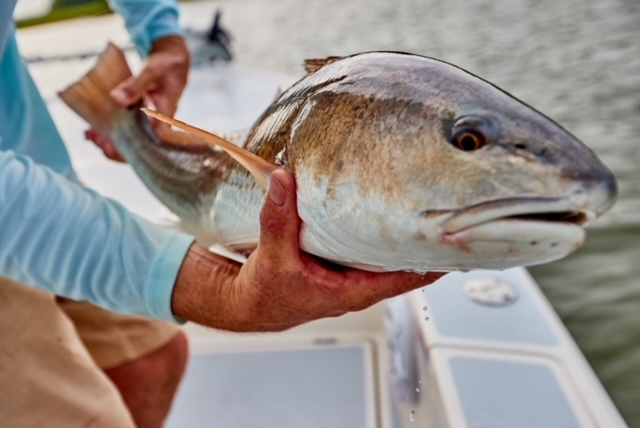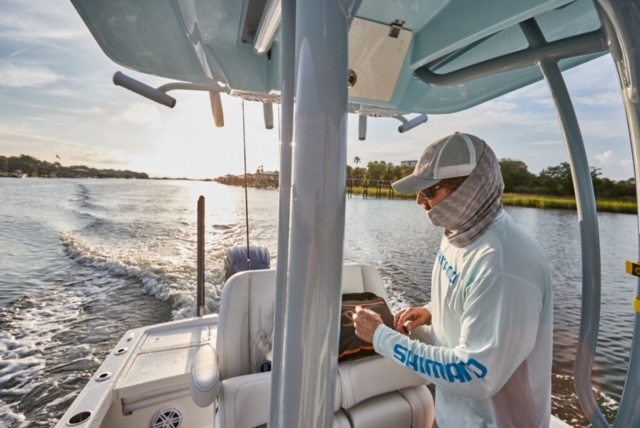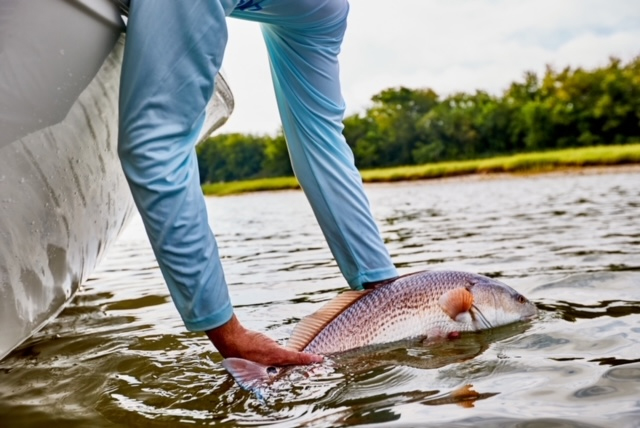Story by Capt. Peter Brown
Photos by Chris McEniry
Here in coastal South Carolina, we are fortunate to have a year-round fishery. Every season has its attributes when it comes to being on the water, but local anglers know that fall is a very special time of year. The summer crowds are gone, days are getting shorter and many would-be anglers are preoccupied with various other hunting and sports seasons.
Falling temperatures means some of the favorite migratory species will move on, but for inshore fishing the end of summer means it’s just the beginning of the best time of the year. There are a few things to keep in mind for this change of seasons that will help make your fall fishing more enjoyable and more productive. Here are a few tips for maximizing your time on the water this fall.

LOCATION
Fall fishing can be good in a variety of areas. Oyster beds and mud flats are favorite haunts for schooling redfish. A depression or shallow creek bed will often hold fish that are waiting for food to leave the flats or creeks. Structure like tree-lined cut-away banks, rock jetties, docks and sea walls adjacent to deeper water will hold fish throughout the fall. Any combination of these features is worth a cast or three. Look for bends in the creeks with naturally deeper holes (often 4 to 15 feet deep back in the creeks). Water temperatures will range from the high 70s down to the low 60s from mid-September through mid-December, and this temperature range is ideal for redfish, seatrout and flounder.
TIDES
People often ask me what the best tide is for fishing. With tidal fluctuations anywhere from 4 to 8 feet, the best tide depends on when, where and how you are fishing. Preferences differ, however there are some tidal trends that produce consistently depending on the species.
For redfish, most guides in this region prefer an outgoing tide, from high to low while the water is moving. Low incoming can be excellent as well. Watch the moon because the larger the tide swing and the faster the current, the shorter the window for ideal conditions. High tide can also be ideal for sight fishing on sunny days.
For trout, incoming tides are generally best for catching numbers. Trout love moving, clear water so often the best bite is when the water starts really moving in. Outgoing tide can be very good as well, particularly near creek mouths that empty into larger channels. Also look for “drops” where the water depth changes quickly and larger trout will hold to ambush baitfish and shrimp. However, the most extreme tides can be harder to fish because of extreme currents, so fishing the tides between the bigger moon tides can be best.

WEATHER
In the fall, the fish are generally trying to feed as water temperatures drop, so anytime can be worth going. But there are some specific patterns that are especially good for catching fish, like right before a front rolls in. Look for fish to be most active as weather or a front approach the area.
Redfish, trout and flounder will feed well in shallow water on cloudy days, but sunny days can also produce well as inshore fish will aggressively hit artificial lures in clear, moving water. After a front the fish can still be active, but may require a slower retrieve or a different location as fish may hold tight to structure.
CLOTHING
The temperate climate in the fall is typically very pleasant, but it can be unpredictable. It’s important to be prepared for the weather and the sun. Everyone has their preferences, but try to have pieces for every situation, from cold to hot, from sunny to rain, and be prepared to add or remove layers as the day progresses. A cold, wet ride in can ruin an otherwise awesome day on the water.

PRO TIP
Fall fishing is as good as it gets here, and you can usually expect to find fish schooling and feeding readily. Having the right gear certainly helps, but there is simply no substitute for time on the water. I fish the shallow estuaries of the South Carolina Lowcountry in a 2500 Pathfinder Hybrid bay boat, and one of the most important techniques on a boat like that is “boat control.” Boats that are equipped with electric trolling motors with “anchor lock” as well as a shallow water anchor system like a Power Pole do have a huge advantage when sneaking up on fish in the inshore waters of the Lowcountry at this time of year. Having the right gear is the first step – learning how to use it to your very best advantage is the necessary second step.
Figuring out the successful formula for fall fishing – everything from reading weather and tides to proper gear and technique – comes mostly from experience, so get out there often as you can and enjoy the process.
Contact Capt. Peter Brown of Saltwater Charters LLC in Charleston, South Carolina, at 843-830-0448, phbsc1@gmail.com or @saltwaterchartersllc.







